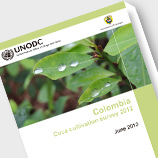8 August 2013 - The area under coca crop cultivation in Colombia fell by a quarter in 2012 to 48,000 hectares (ha), down from 6
 4,000 ha in 2011. This was the national picture at the end of 2012.
4,000 ha in 2011. This was the national picture at the end of 2012.
A survey jointly conducted by the Government of Colombia and UNODC shows that coca bush cultivation affected 23 of the country's 32 departments; decreased in 17 departments; increased in the 3 departments of Norte de Santander, Caquetá and Chocó; and remained unchanged in the remaining 3.
Satellite images and field surveys showed that some 80 per cent of cultivation was concentrated in 8 departments, with roughly half taking place in 3 of those departments. Nariño, Putumayo, Guaviare and Cauca saw the greatest declines and 7 departments are now below the 100-hectare level.
The Government manually eradicated almost 30, 500 ha of coca bushes in 2012 and sprayed nearly 100,550 ha of coca crops from the air, similar to 2011 levels. These efforts thus curbed the area affected by coca cultivation in 2012 from 135,000 ha to 48,000 ha by the end of the year.
The farm-gate value of coca leaf and derivatives (coca paste, cocaine base) in 2012 was estimated at US$ 370 million, down from the 2011 value of US$422 million, and worth 0.2 per cent of national GDP and 3 per cent of the GDP related to the agricultural sector. In contrast, prices remained stable for cocaine base (+3.9 per cent), paste (-0.4 per cent), and chlorhydrate (-2.4 per cent). Recent studies show that the coca leaf yield per hectare has decreased. The number of households involved in coca cultivation fell 3 per cent from 62,400 in 2011 to 60,600 in 2012.
Annual yields of coca leaf have been decreasing since 2005 but the market price has picked up almost 10 per cent. The production of 100 per cent pure cocaine ranged from between 240 and 377 tons. Since estimates are uncertain, the 2012 figure may be calculated at 309 tons, which is comparable to the 2011 figure. Cocaine seizures of unknown purity rose 21 per cent from some 156 metric tons in 2011 to around 188 tons in 2012.
With the average gross income of a farmer selling coca leaf is estimated at USD $1, 220 per year, coca production does not fetch the same lucrative rewards as in the past; in 2005, 82 per cent of coca growers were dependent on the crop and its derivatives, whereas the latest survey points to some 60 per cent of farmers - 30 per cent fewer - considering coca-related activities as their mainstay. Some 30 per cent of farmers are currently involved in the conversion of coca leaf into base cocaine, half the 2005 figure.
"The impact of the government efforts to eradicate illicit coca crop is visible. However, the 2012 and previous surveys show that after eradication takes place, cultivation often resumes in new or previously cleared fields. Therefore, crop eradication, even when it yields positive results, must be complemented by alternative livelihood schemes to improve social, economic and environmental conditions and to achieve a sustainable reduction in the area under cultivation" said Bo Mathiasen, UNODC Representative in Colombia.
In 2012, investments of almost US$250 million were made in the framework of the Policy of Territorial Consolidation to tackle the factors making territories vulnerable to coca cultivation while promoting development, notably in the provinces of Nariño, Antioquia, Putumayo, Huila and Cauca.